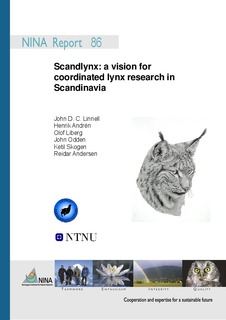Scandlynx: a vision for coordinated lynx research in Scandinavia
Research report

Åpne
Permanent lenke
http://hdl.handle.net/11250/2430631Utgivelsesdato
2005Metadata
Vis full innførselSamlinger
- NINA Rapport/NINA Report [2337]
- Publikasjoner fra CRIStin - NINA [2364]
Sammendrag
Linnell, J.D.C., Andrén, H., Liberg, O., Odden, J., Skogen, K. og Andersen, R. 2005. - Scandlynx: a vision for coordinated lynx research in Scandinavia. - NINA Rapport 86. 26 s. This document presents a vision for research needs on Eurasian lynx in Scandinavia. The focus is on applied research to provide managers with the knowledge they need to ensure lynx management is sustainable in the future, although we underline the scientific value of this research as well. We propose to fully integrate lynx research in Norway and Sweden under the umbrella of a coordinated project called Scandlynx. This allows us to address research questions in the site which offers the best opportunities and reduced duplication of effort. We propose to maintain 3 intensive study sites - one in Sarek in northern Sweden, a second in Bergslagen in south-central Sweden and a third spanning the border between southeastern Norway (Hedmark, Akershus and Østfold counties) and the Swedish counties of Värmland and Västra Götaland. Together these sites should fulfill most of the needs outlined in our vision. The priority for data collection is to follow a sample of adult females and their offspring for as many years as possible. This allows the collection of demographic data, and dispersal data. The management issues which are regarded as being most important (1) harvest - which requires data on lynx demographics in contrasting conditions, and (2) lynx colonization of southern Sweden which requires data on dispersal. Secondary topics focus on predator-prey relationships with roe deer, intra-guild interactions with red fox, wolf and wolverine, and depredation on semi-domestic reindeer.